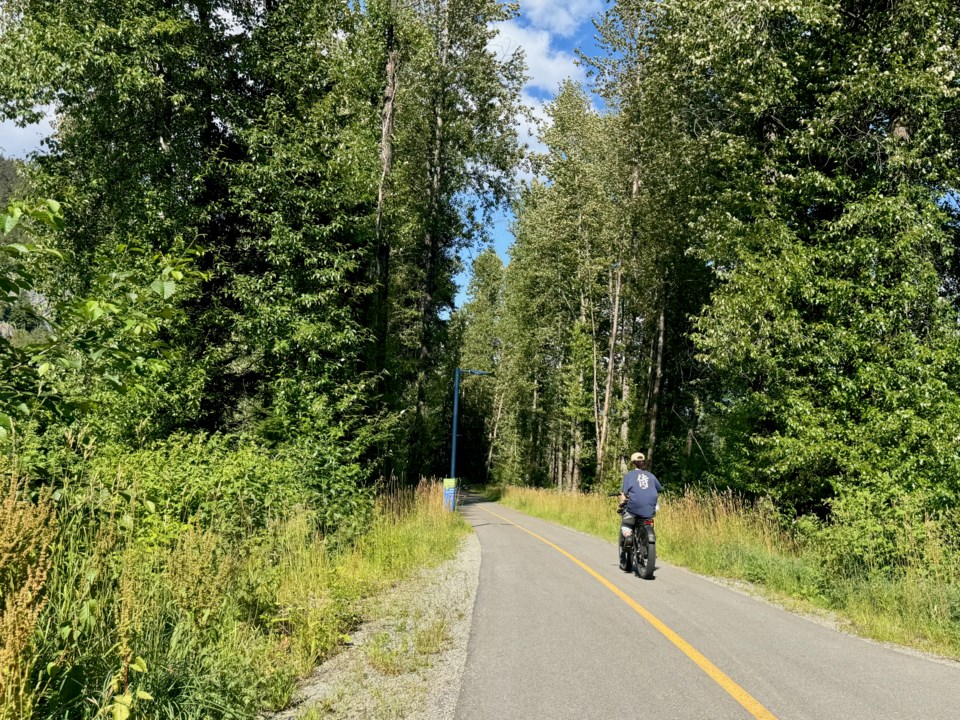As e-bike popularity surges across North America, micromobility has become a convenient, emission-free way to travel through Whistler—especially for those looking to avoid traffic.
But with limited infrastructure and increasing speeds, some are raising questions about safety and regulation.
Whistler resident Richard Kinar said e-bikes have evolved to the point that more public discussion is needed around their use on multi-use trails like the Valley Trail, where pedestrians, dog walkers, children and riders often share the same space.
“They are often going far faster than anybody has anticipated. I think it’s an evolution and Transport Canada hasn’t kept up,” said Kinar. “People [are] e-biking, talking on cellphones, using selfie sticks—and I think it’s time we start talking about what’s acceptable.”
Kinar emphasized he supports e-bikes for their environmental and commuting benefits. But with electric bikes now capable of speeds well above the federally regulated 32 km/h limit—particularly when modified using tutorials easily found online—he worries about future injuries and legal liability.
“If I’m struck by one of these things, eventually people could sue the municipality,” he said. “Or insurers would ask for regulation.”
Under federal law, e-bikes must not exceed 32 km/h and are limited to a 500-watt motor. Yet as some models blur the lines between e-bikes and electric motorcycles, Kinar believes they should be treated accordingly.
“They’re not electrically assisted bikes—they’re bikes with motors,” he said. “If they had gas-powered engines, people would draw the line.”
He would like to see the Resort Municipality of Whistler (RMOW) bring a resolution to the Union of British Columbia Municipalities (UBCM) to address concerns and seek provincial guidance.
In an interview with Pique, Mayor Jack Crompton confirmed there are currently no plans to introduce a UBCM resolution on e-bike regulation.
“I haven’t had the opportunity to review the UBCM resolution package yet, but the RMOW has not made a resolution,” Crompton said.
While Transport Canada regulates e-bike specifications, municipalities have limited authority over speed or sale, Crompton added. However, Crompton noted the RMOW is taking steps to better integrate e-bikes into Whistler’s transportation network.
“In alignment with our Active Transportation Strategy, the development of an active transportation network plan is underway to help us better understand how e-bike commuters fit into the network,” he said. “We’ve also been advocating to the province for additional cyclist supports along the highway.”
Whistler is also planning to include e-bike and micromobility guidance in the updated Parks Use Bylaw expected to go before council this fall. Crompton said the new policy will emphasize rider behaviour rather than speed enforcement, which remains difficult with limited bylaw resources.
“The challenge of covering more than 50 kilometres of trails with as many access points as we have is pretty challenging,” Crompton said. “Our staff are not RCMP-qualified law enforcement people, so enforcing on higher-priority bylaw needs with higher success rates elsewhere in the community is what we are prioritizing at the moment.”
That means education, not enforcement, is the focus for now. Since June, the RMOW has installed more than 150 signs and trail stencils as part of an awareness campaign that will continue through August.
“The signage focuses on respecting all users, identifying slow zones and encouraging riders travelling fast to use adjacent municipal roads,” said Crompton. “Education is the best tool we have right now.”
Still, as e-bike use grows, some are looking at additional strategies. Insp. Robert Dykstra of the Whistler RCMP said the issue is on their radar.
“If you’re on an e-bike, wear a helmet and be cognizant of other people around you,” he said. “You’re definitely going faster than other people. Pedestrians have the right-of-way on these paths.”
Dykstra emphasized that while criminal enforcement is possible in the event of accidents, most e-bike issues fall under regulatory frameworks—making collaboration between municipalities, health authorities, and community members vital.
As Kinar puts it: “When I sit with my friends and talk about how helpless we feel on the Valley Trail when [e-bikes] are going this fast, we need to discuss how we deal with them.”
With usage increasing rapidly—Evolve’s e-bike program in Whistler saw a 130-per-cent rise in rides in 2024—the conversation around safe shared trails is becoming more urgent.
“We need data from medical centres that have high use,” Kinar said. “And we need a resolution before the UBCM.”




